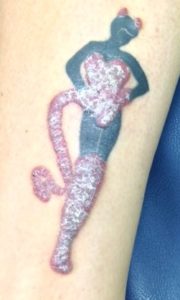Successful removal of hyperkeratotic-lichenoid reaction to red ink tattoo with preserving the whole tattoo using a skin grafting knife
Assist. Prof. Boštjan Mlakar, M.D., Ph.D.
Private clinic ZDRAV SPLET, Maribor, Slovenia
bostjan.mlakar(at)zdravsvet.si
Introduction
With increasing popularity of tattoo body decorations, the reports of medical complications with tattoos have increased in parallel. While tattoo reactions can resolve spontaneously, they often last for months or even years, despite the different treatment methods. In our case we present the successful removal of hyperkeratotic-lichenoid reaction to red ink using a simple and cheap skin grafting knife. The whole tattoo was preserved with a good aesthetic result with minimal scarring.
Case report
A 38-year old female patient complained of itching, followed by the appearance of raised scaly erythematous and hyperkeratotic-lichenoid lesions over the site of red ink on her lower leg. The black ink in the tattoo was not affected (fig. 1). The tattoo had been placed 8 weeks prior to her presentation and the first symptoms occurred 3 weeks after the injection. The patient refused the suggested biopsies. Intralesional corticosteroids were administered twice in the period of 2 months and oral antihistamines were prescribed for this period. Only mild improvement of itching was achieved. The patient was referred to a laser specialist who suggested continuous steroid therapy. We suggested the experimental partial removal of tattoo using a skin grafting knife. After another unsuccessful steroid therapy, the patient agreed with our proposal. Eight months after the tattoo was injected, only elevated regions of red pigment were removed using a skin grafting knife in the same manner as thin layers of burned tissue are removed (fig. 2). We decided for that procedure because the nonsurgical therapy we could offer failed and the patient demanded a quick and cheap solution of the problem. She agreed with the complete surgical excision of the tattoo if the proposed procedure using a skin grafting knife failed or if aesthetic result after healing the wound would not be acceptable. The procedure was performed using local tumescent anesthesia. Antibiotic vaseline mesh was administered and changed daily for 14 days. Once the skin had reepithelialized, topical silicon jelly was used for 2 months. The 12 months follow-up shows a good aesthetic result with minimal scarring and without any symptoms of allergy. The whole tattoo was preserved (fig. 3).
Conclusions
Skin grafting or other abrasive procedures are usually the last option to solve tattoo reactions because of not optimal cosmetic result with more or less scarring wounds. However, in our case we have success in removing hyperkeratotic-lichenoid reaction to red ink using a simple and cheap skin grafting knife. We could not find any similar case in literature regarding preserving the whole tattoo using the skin grafting knife technique.





